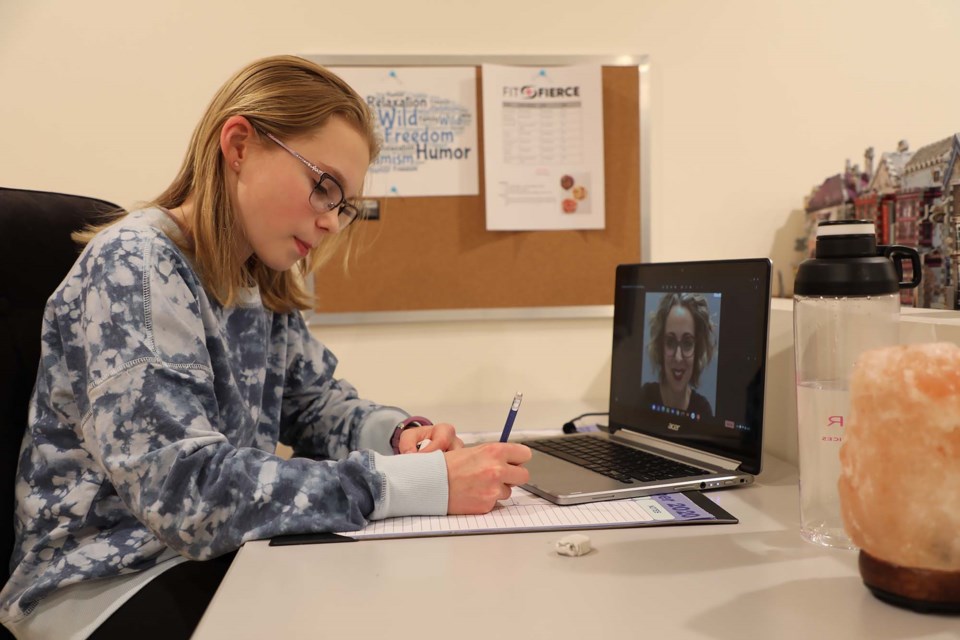Life with the pandemic has become almost second-nature for Evan Charrois at Morinville Community High School.
Like thousands of other St. Albert and Sturgeon County students, he’s been going to school since September during a once-in-a-century pandemic, which means a whole pile of safety procedures to follow.
“It is still a hassle,” he said, but it’s become pretty easy by now.
"When you walk into the classroom it’s second nature to hit the sanitizer (bottle),” he said, and to always strap on that face mask when you step out of the car.
The Gazette touched base this week with St. Albert and Sturgeon County students and teachers to check on the state of schooling at the start of the second quarter.
Learning@Home
Muriel Martin Grade 6 student Erin Marsh started her second term of online learning in about mid-November. School for her was basically one long Google Meet session, during which she could see and speak with her teacher and classmates over video.
“It’s definitely not as interactive as a normal classroom,” Marsh said, as you don’t get to play with your classmates outside at recess, but she did get to have dance and computer coding sessions with them.
Marsh said she picked online learning in the first quarter due to concerns about the pandemic, and decided to stick with it due to high case numbers and the fact that she kind of enjoyed it.
“You get to sleep in a little later,” she noted, as you don’t have to catch a bus, and she really likes her teacher.
About 1,000 students have signed up for the St. Albert Public Online School this quarter, which is basically the same number that did in September, said principal Catherine Coyne.
Greater St. Albert Catholic deputy superintendent Rhonda Nixon said her online school had held steady at about 580 students, but saw a drop in elementary and a rise in secondary students – a shift possibly caused by some COVID-19 outbreaks at the secondary school level last quarter.
Marsh said she learned all the typical subjects in her online class, but didn't have her usual music and phys-ed classes. (Those subjects were sprinkled throughout other lessons.) On the plus side, that made for a slightly shorter school day.
St. Albert Public Online School teacher Patricia Toth, who is based at Lois E. Hole Elementary, said she taught her classes with a mix of live and pre-recorded lessons and evaluated students through chats, Google Docs, and the video-sharing site Flipgrid. Joint workouts, chats, and game sessions at morning and recess had become essential in her efforts to connect with each student.
“This is the only socialization they have in the daytime,” Toth said, and it helps them feel like they’re in a regular classroom.
The online format does make it easier to keep the noise down in class as students can mute their microphones, Toth continued. The limitations of online learning also make you focus more on the material, allowing for more in-depth exploration and faster progression.
Some students say they miss their friends, and Toth said she takes time to talk about those feelings with them. One of her students has no one at home with which to share his passion for toy cars, so she “plays” with him during recess through video chat.
Marsh said she hopes to go back to school in person eventually, possibly next quarter, and isn’t sure if she’d like to continue with online learning next year.
In class and masked
MCHS teacher Neil Korotash has been teaching his 30-odd Biology students in class at the same time as he vid-casts lessons to about five online students. It has been a challenge, as it is easy to forget about the kids in the chat room, but he said the format made it easy for students who have to stay home due to illness to keep up with the course.
“One of the biggest challenges has been the flexibility we need to be able to give to students,” he said.
Because some students might miss lessons due to quarantine, Korotash said he has had to give his classes a lot of leeway when it comes to deadlines. He can’t always send students home with lab equipment either, so sometimes he has to create different assignments for his at-home corps.
Charrois said it is much more difficult to socialize at school due to the pandemic – you can hang out with a small group of friends if you wear masks, but there’s no after-school house gatherings allowed. Due to the cohort system (which sees students stick with the same classmates all term), you’re also very unlikely to meet any new students.
On the plus side, Charrois said the quarterly system means high school students take just two three-hour courses a day, which gives you more time to focus on one subject. It also means less homework – teachers don’t want to teach for three hours, so most give you in-class time for assignments.
One definite minus to school during the pandemic has been the end to Drama productions, Charrois said, as his fellow performers were like a second family to him.
“It definitely sucks.”




